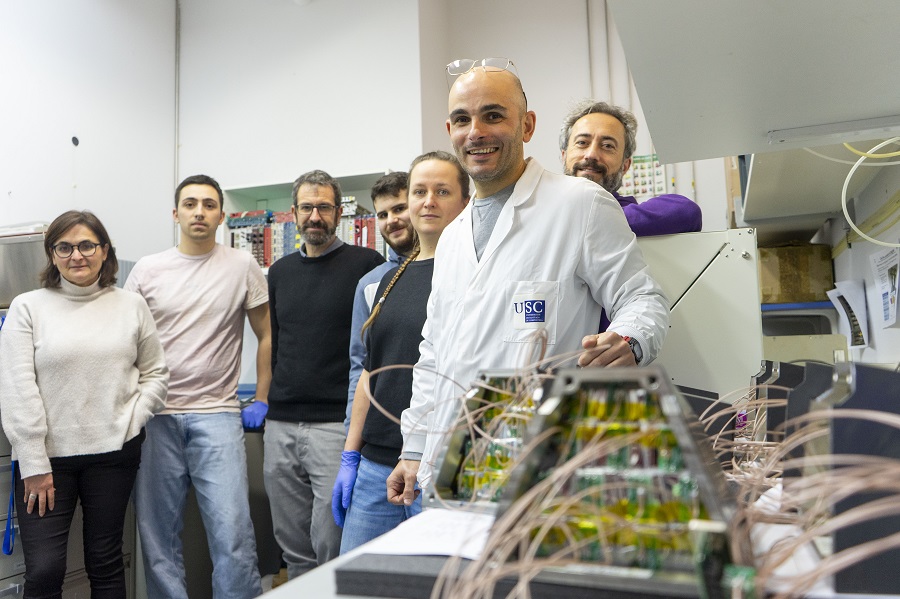Researchers from the Instituto Galego de Física de Altas Enerxías (IGFAE), a joint centre of the University of Santiago de Compostela and the Xunta de Galicia, travelled in recent days to the city of Darmstadt (Germany) to install the last modules of the CALIFA detector, a calorimeter that will be integrated into the international research centre FAIR. This milestone represents the culmination of almost 20 years of work in the design and subsequent construction of the detector, in a project led by the IGFAE.
CALIFA will be installed in the R3B experiment, one of the most important scientific collaborations of FAIR. This experiment, which currently involves more than 250 scientists from 15 countries, is dedicated to the study of the structure and dynamics of the atomic nucleus and has been coordinated since May 2017 by the researcher Dolores Cortina. Since 2005, IGFAE staff have been involved in this experiment, which also includes the DSN (Design and Numerical Simulation) group at the University of Vigo, which is responsible for the design and construction of the mechanical structure of the detector. The project has also involved several Galician companies specialised in the manufacture of carbon fibre, precision machining and metrology.
CEPA detection modules
In this last phase, the team has completed the construction and assembly of the CALIFA detection modules known as CEPA. This step will substantially improve the detection of gamma radiation and high-energy charged particles produced during the nuclear reaction. It will significantly increase the efficiency of the R3B experiment and facilitate precision measurements by taking advantage of the accelerated ion beams in FAIR.
The delivery of CEPA ends a construction phase of CALIFA that has lasted more than 10 years (in addition to the previous research and design) in which personnel from Spain, Germany and Sweden have participated. The current cost of the CALIFA detector exceeds 3.8 million euros, 24% of which has been financed with funds raised by this research team. Once the work is completed, the final cost of CALIFA will exceed 5 million.
The CALIFA calorimeter is capable of simultaneously detecting charged particles and gamma radiation, covering an unprecedented energy range from kiloelectronvolts (KeV) to hundreds of megaelectronvolts (MeV). The detection technology used in this type of detectors, as well as the techniques for reconstructing the information collected, are like those developed in the field of medical imaging. In fact, the R&D carried out for CALIFA has given rise to a “proof of concept” project aimed at accelerating the transfer of knowledge and results generated in the field of fundamental research.
About R3B & FAIR
The R3B experiment (Reactions with Relativistic Radioactive Beams) uses radioactive ions at near-light speeds to carry out a broad programme of research into questions crucial to nuclear physics. These include the study of fundamental properties of atomic nuclei and the force responsible for binding the protons and neutrons that form them, as well as the importance of correlations between nucleons. Thus, R3B also aims to reproduce the reactions that take place in stars and that are responsible for generating their energy and creating the elements we see in the Universe.
R3B is one of the experiments being developed at FAIR (Facility for Antiproton and Ion Research in Europe), a new international research centre for the study of the structure and properties of the visible matter that makes up the Universe. It is currently under construction. Once completed, FAIR will be equipped with the world’s most powerful antiproton and heavy ion accelerators. The centre will host more than 3,000 people from 50 countries, who will carry out basic and applied research in the field of nuclear physics. The construction cost of around €1.5 billion is funded by a consortium of nine countries,
The IGFAE team participating in R3B is composed by Dolores Cortina, Héctor Álvarez, José Benlliure, Martina Feijoo, Antía González, David González, Gabriel Martínez, José Luis Rodríguez, and Georgina Xifra.
